Terraforming Mars is a strategy board game that incorporates resource management, drafting, and tile placement. It’s set in the 2400s with the players taking the role of tenacious corporations who are each looking to spend entire generations of settlers to be the first to make Mars habitable. Each corporation competes for getting the most victory points, which can be earned not only by contributing to the Mars terraforming process but also for doing commendable things in the game.
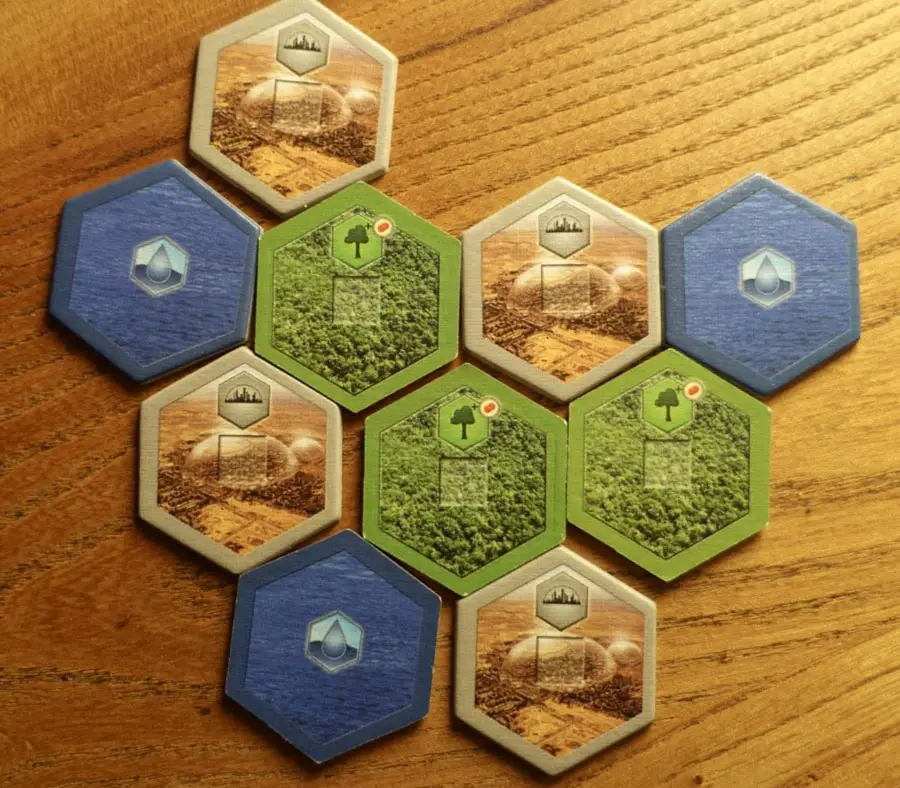
Ten poradnik Jak grać pomoże ci poruszać się po skomplikowanej i czasami mylącej strukturze mechaniki Terraformacji Marsa.
Komponenty gry
Pudełko Terraformacja Marsa zawiera ponad 230 kart do gry, 5 plansz dla graczy, dokładną mapę planety Mars, ponad 400 wielokolorowych znaczników (200 przezroczystych znaczników, 200 znaczników zasobów, plus 3 znaczniki planszy gry) oraz 80 kafelków do umieszczenia na planszy w celu oznaczenia oceanów, zieleni, miast i kafelków specjalnych.

Zawiera również szczegółową książkę zasad, która wskazuje zastosowania i funkcje każdego elementu gry.
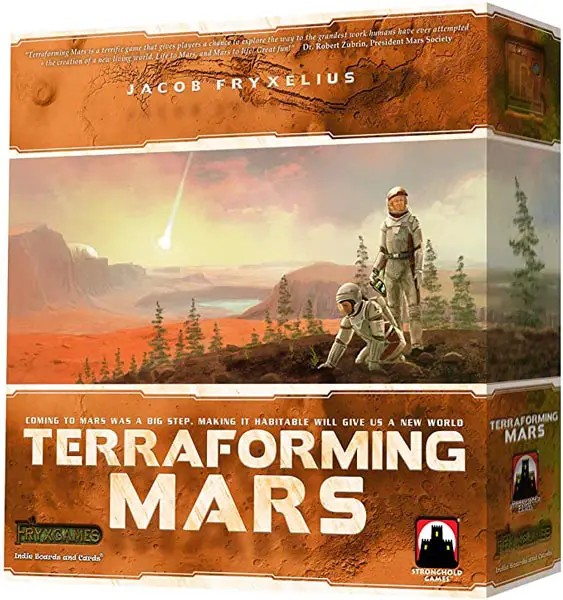
- Rywalizuj o różne kamienie milowe i nagrody warte wiele VPS-ów
- Ponad 200 różnych projektów do zrealizowania
Ustawienia i podstawy zasad terraformowania Marsa
Krok 1
Aby rozpocząć grę, należy umieścić planszę gry na środku stołu i ustawić wszystkie 9 płytek oceanu na sześciokątnym miejscu w prawej górnej części planszy.
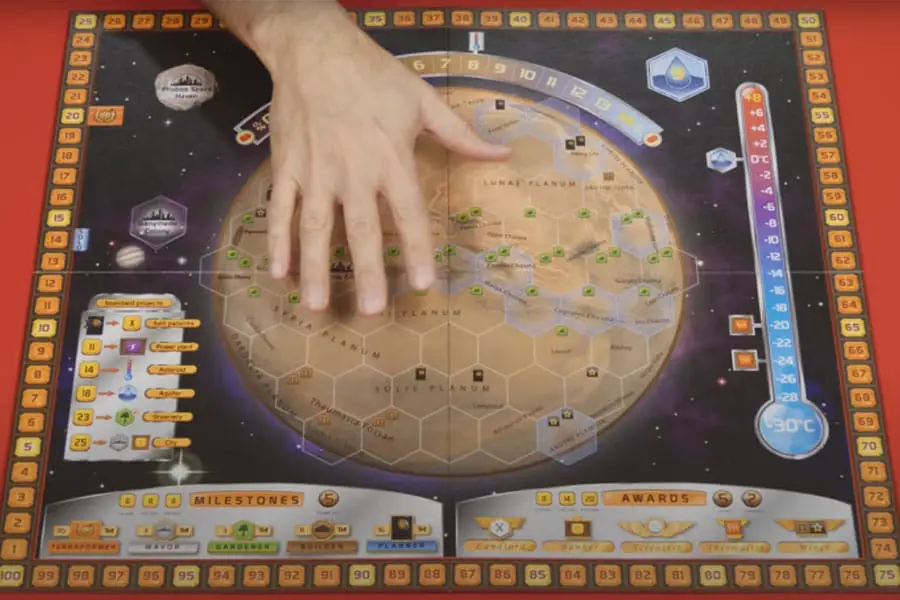
Krok 2
On the edge of the board is a track that represents your Terraform Rating (TR) levels; place 1 white marker on the “1” space.
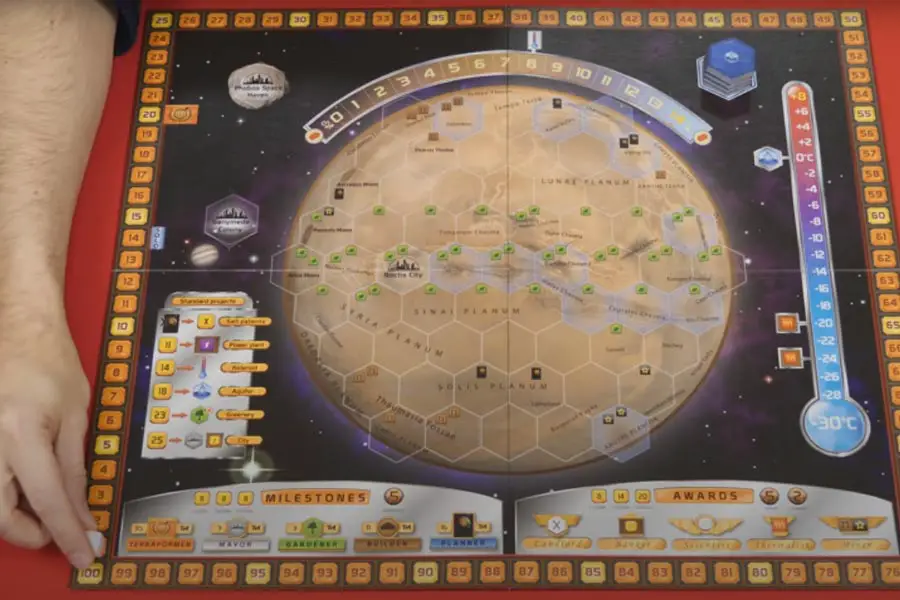
Krok 3
The oxygen levels are measured using the oxygen scale which is the arched figure on top of the board; place 1 white marker on the “0%” space.
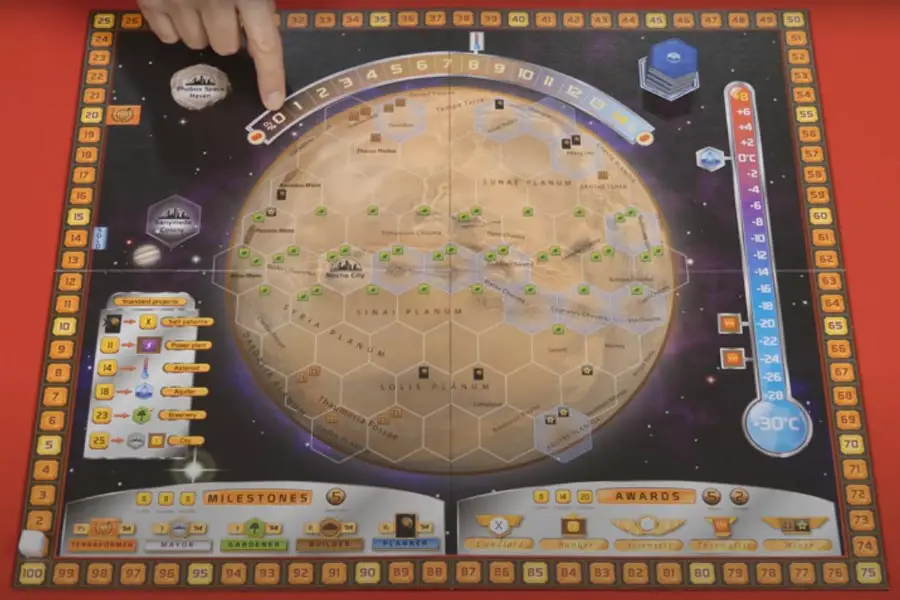
Krok 4
Finally, the temperature is measured using the thermometer located on the right-hand corner of the board; place 1 white marker on the “30°C” space.

Krok 5
Now, have each player collect one game board and cubes in one of the 5 player colors. On your player board, you’ll find the symbols for the six types of resources available in the game: Megacredits, Steel, Titanium, Plants, Energy, and Heat.
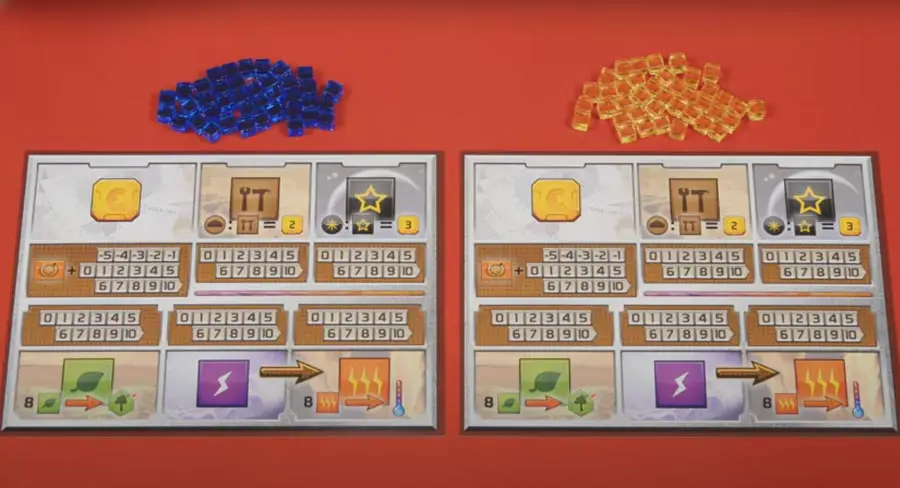
Krok 6
On your player board, you’ll also find a track that helps you monitor your corporation’s production. Place 1 colored marker on the “1” space of each track.

Put another colored marker on the “20” space of the TR track.
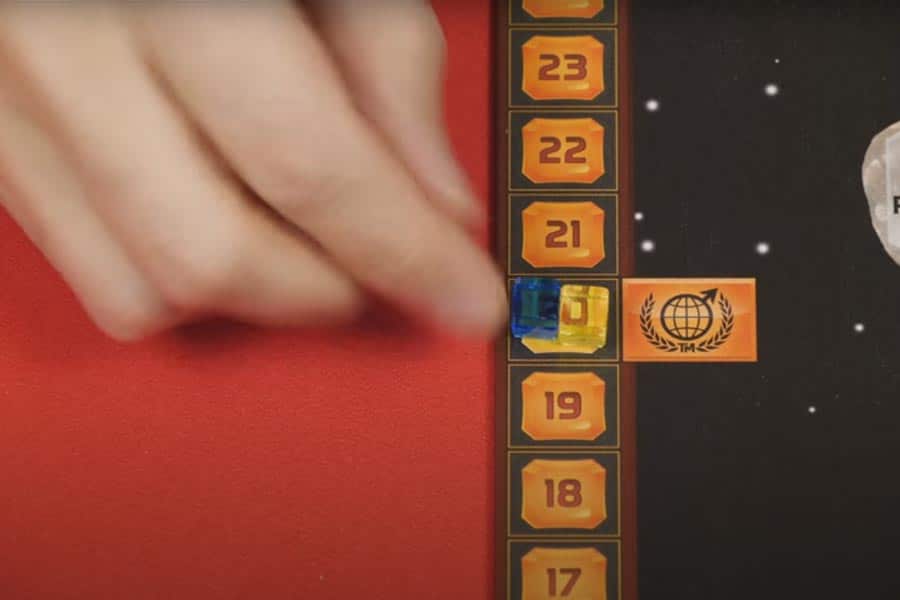
Krok 7
W tym kroku każdy gracz otrzymuje dwie losowe karty korporacji do wyboru. Karty te wskazują jego bazowe zasoby na początku gry. Za każdym razem, gdy zdobędziesz określoną ilość dowolnego zasobu z kart lub osiągnięć, bierzesz odpowiednią liczbę kostek z zasobów i umieszczasz je na swojej planszy gracza.
- Bronze Cubes – worth 1 each
- Silver Cubes – worth 5 each
- Gold Cubes – worth 10 each
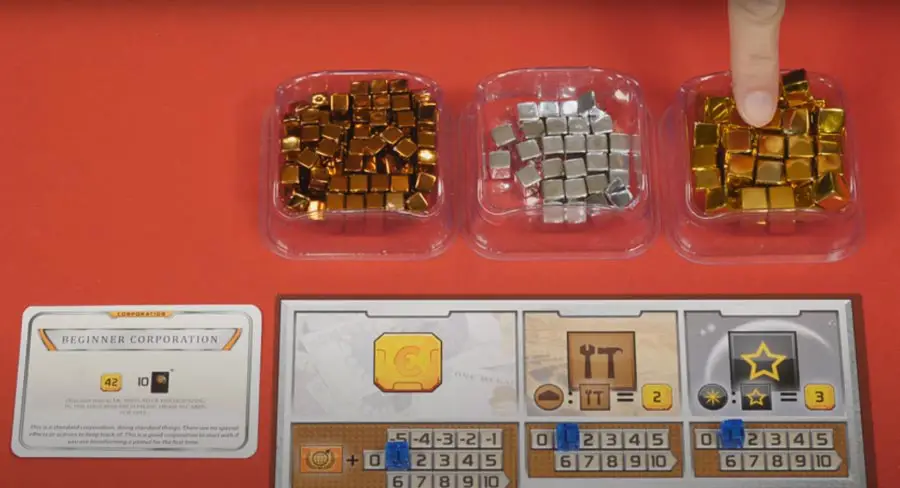
Krok 8
On top of these corporation cards, players also acquire 10 unique project cards which each represent different functions such as introducing plant life or animal life, hurling asteroids at Mars’ surface to increase the temperature, as well as building cities. These cards can also reward the player with immediate bonuses that help increase their chances of winning the game.
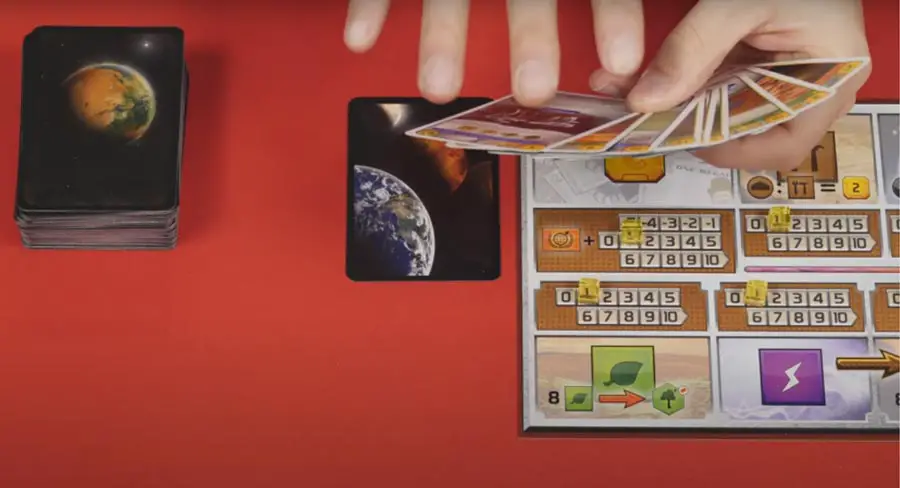
Players have the choice of buying all 10 cards or only keep a select few in their hands. Each card costs 3 Megacredits, so if you want to keep all 10, you’ll need to pay 30 for the Supply.
Krok 9
Any cards that aren’t chosen are placed facedown on the table to start a discard pile.
It’s important to note that buying cards can become quite pricy at some point in the game. When this happens, you can always utilize Standard Projects to take yourself further in the game.
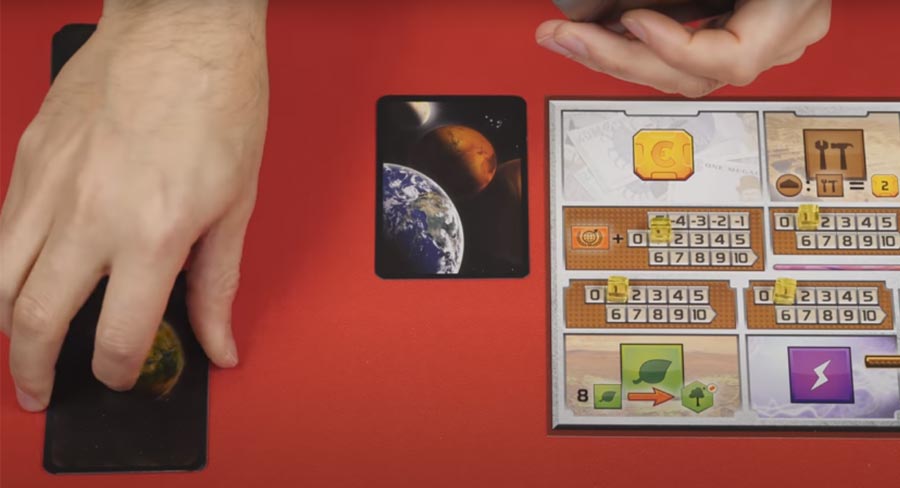
Trzy parametry globalne
Każdy gracz w Terraformacji Marsa angażuje się w różne wydarzenia, które pomagają poprawić 3 Globalne Parametry: temperaturę, poziom oceanów i poziom tlenu.
Raising temperature levels by one step doesn’t gain you any points. You just move the white marker up one space. However, when you reach certain points on the scale, you earn corresponding rewards for your corporation. For instance, when you reach -24°C and -20°C it lets you raise your heat production, and at 0°C it lets you place an ocean tile.
Ocean tiles can only be placed on designated ocean spaces — these are indicated by the hexagons with the blue outlines on the game board. You get 2 main credits for each adjacent tile you place.
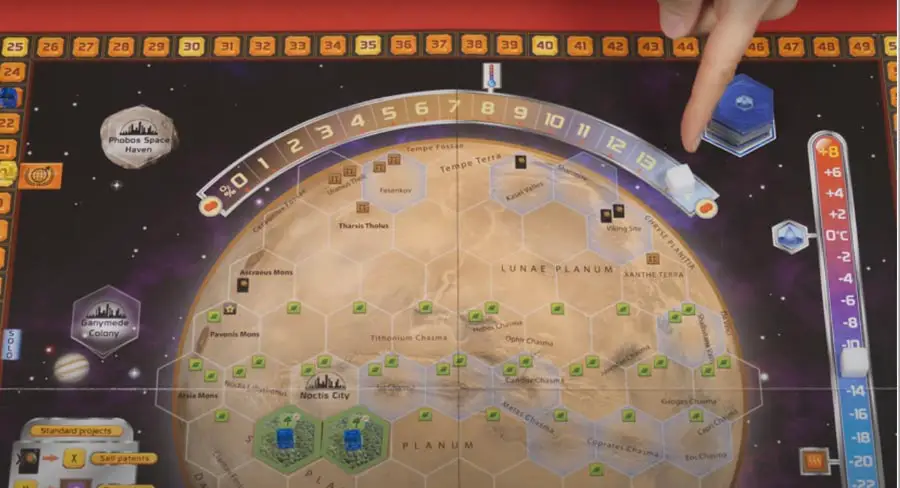
Na koniec mamy tlen.
Some cards can help increase the oxygen levels directly, but most of the time you’ll raise this parameter by placing greenery tiles on the board. When placing one of these greenery tiles, if possible, it must be next to a tile that you own.
If you don’t yet own any of the tiles on the board or don’t have enough space next to the ones that you own, you can place your greenery tile on any free space, except for those meant for ocean tiles and special locations which are reserved for cities.
Po umieszczeniu płytki z zielenią, podnieś o jeden stopień poziom tlenu, który w pewnym momencie, później podniesie również temperaturę.
Whenever you advance in any of these parameters, you’ll also be able to advance your TR by one, which then equal points and help you earn more money in late game.
Gdy wszystkie trzy parametry zostaną ustawione, rozpoczyna się gra końcowa, a gracze mają ostatnią okazję, by uczynić Marsa bardziej zielonym przed podliczeniem punktów.
Rozgrywka i pokolenia
Terraformowanie Marsa takes place over the course of several “generations” represented by game rounds. Each round is broken into four phases: player order phase, research phase, action phase, and production phase. (You’ll find these phases in the included Player’s Guide.)
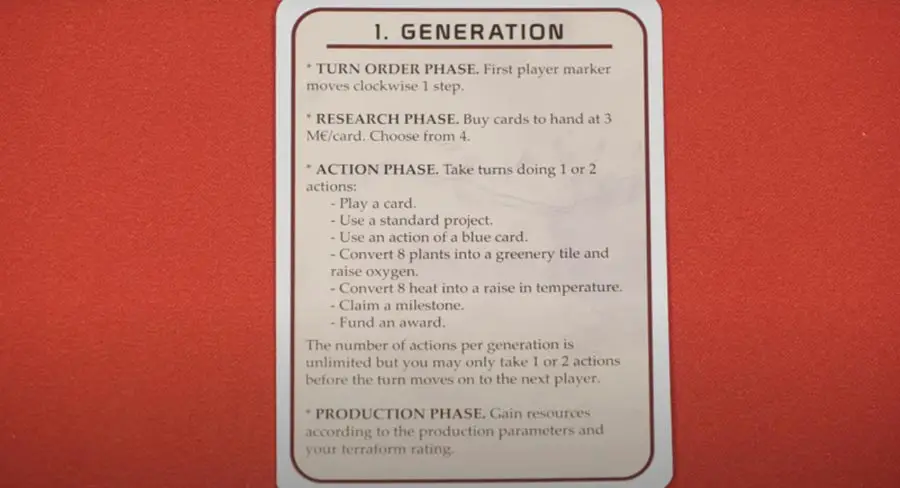
Faza działania
During the action phase, each player gets a chance to play one or two actions, starting from the player with the first player token. If you play two actions during a turn, both actions can be the same or different. Once the first player is done performing an action, the game continues in clockwise order until everyone has played their turn. If you can’t or don’t want to perform an action, you can skip the turn and pass it to the next player.
Istnieje 7 możliwych akcji, które możesz wybrać i znajdziesz je na swojej karcie referencyjnej. Są to:
- Zagraj w kartę.
- Użyj projektu standardowego.
- Użyj akcji z niebieskiej karty.
- Zamień 8 roślin na kafelki zieleni i podnieś tlen.
- Przekształcenie 8 ciepła w celu podniesienia temperatury.
- Zgłoś kamień milowy.
- Ufunduj nagrodę.
Zagranie kartą
Pierwszym rodzajem akcji, którą możesz podjąć jest zagranie karty z ręki. Każda karta w grze jest całkowicie unikalna i każda ma na sobie różne symbole, które reprezentują różne akcje, bonusy lub konsekwencje dla Twojej korporacji.
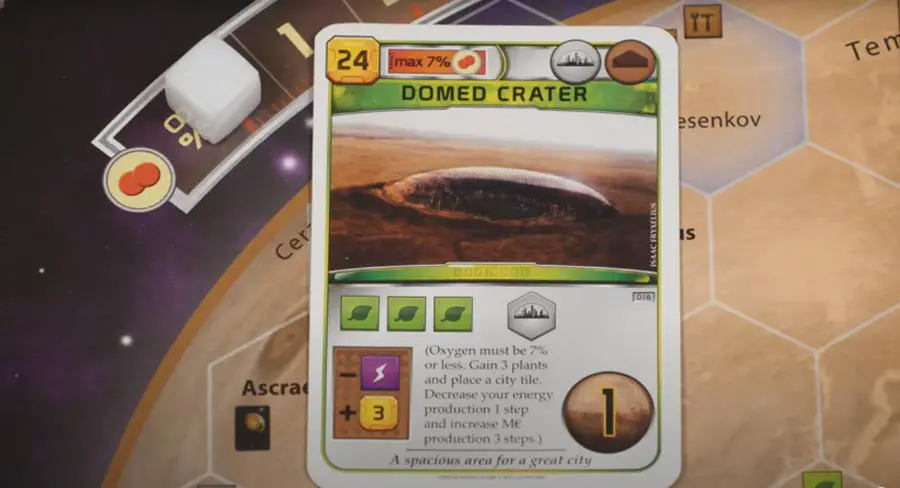
If you aren’t sure what these symbols represent, you can always read the details listed on the card or refer to the back of your Rule’s Book to see a detailed description.
Karty projektów reprezentują działania, które Twoja korporacja może wykonać i istnieją 3 rodzaje: Wydarzenia (czerwone), Projekty zautomatyzowane (zielone) i Projekty aktywne (niebieskie).
Playing a card is simple — there’s a cost of mega credit found on the top left side of the card, and a few other prerequisites beyond that, such as a minimum or maximum amount of some other global parameter or resource.
Czasami koszt produkcji jest wyróżniony czerwoną obwódką, co oznacza, że możesz poprosić dowolnego gracza o pokrycie kosztów w twoim zastępstwie. Alternatywnie, jeśli zasób ma brązową obwódkę, zwiększa on twoją produkcję o liczbę wskazaną na karcie.
Karty mogą być aktywowane tylko raz na rundę, więc kiedy są w grze, umieść na karcie kolorowy znacznik.
Używanie projektu standardowego
Istnieje 6 różnych typów projektów standardowych, które są wymienione na boku tablicy. Są to:
- Sell Patents: Pozwala Ci to odrzucić dowolną kartę z ręki, zyskując za każdą z nich jeden Megakredyt.
- Power Plant: This increases your energy production by “1” step when you pay 11 Megacredits.
- Asteroid: This allows you to increase the temperature level by “1” step after paying 14 Megacredits.
- Aquifer: Pozwala umieścić płytkę oceanu w dowolnym miejscu na planszy po zapłaceniu 18 Megakredytów.
- Greenery: Pozwala umieścić na planszy kafelek zieleni po zapłaceniu 23 Megakredytów.
- City: This allows you to increase your Megacredit production by “1” step and lets you place a city tile on the board after paying 25 Megacredits.
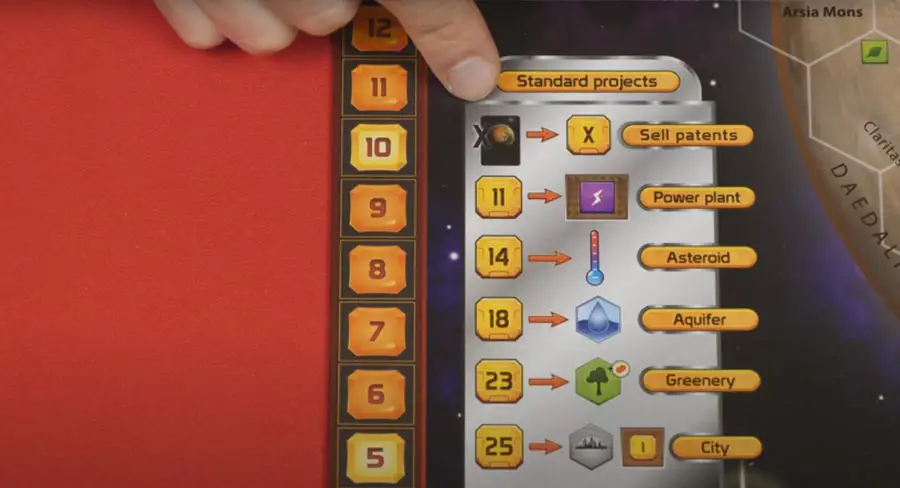
Działania niebieskie
Kolejnym krokiem, który możesz wykonać w swojej turze jest zagranie akcji niebieskich kart.
Playing Blue Action Cards is essentially the same as playing normal cards — you must pay its costs, meet its requirements, and be able to carry out any immediate effects listed on the bottom corner of the card. Blue Actions can only be used once per generation.
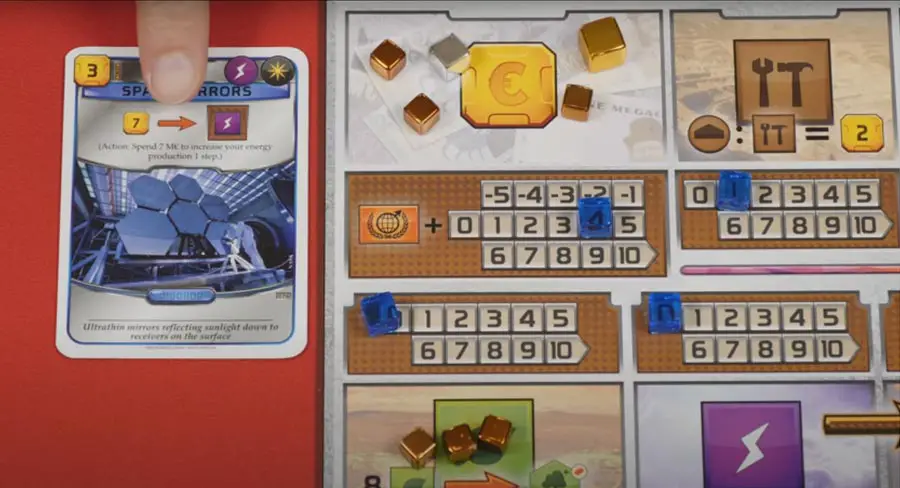
Some Blue Actions won’t have a cost, however, it may indicate the need for other factors such as animals, forests, etc. If such is the case, place one supply cube on the card to make up for the requirement. These will later add up to victory points to win the game.
Handel roślinami w celu podniesienia poziomu zieleni
The fourth action you can take is trading in 8 plants for a Greenery Tile. Greenery tiles increase the Oxygen level, which in turn raises your TR by “1.”
As mentioned before, Greenery tiles are best placed beside a tile that you already own, however, if you don’t have that yet, you may place it on any other vacant spaces on the board and earn corresponding bonuses and points after.

Handel ciepłem w celu podniesienia temperatury
Similar to the previous action, you can also trade in 8 heat to raise the temperature by “1” step and gain “1” TR, to raise your odds of winning.
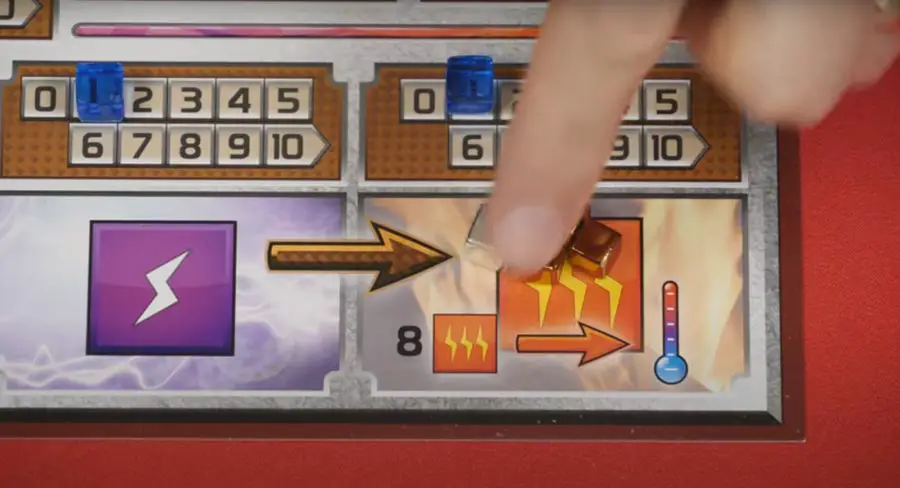
Zgłoś kamień milowy
Podnoszenie kamienia milowego to kolejny rodzaj akcji, którą możesz rozegrać, a rodzaje kamieni milowych znajdziesz w lewym dolnym rogu planszy.
Milestones are like achievements. When you accomplish one of them, you can claim the milestone as an action by paying 8 Megacredits and placing cubes on the milestone you’ve achieved plus the cost. At the end of the game, you’ll gain 5 points for each milestone you’ve claimed.
Istnieje 5 rodzajów kamieni milowych:
- Terraformator: Wymaga posiadania co najmniej 35 TR.
- Burmistrz: Wymaga posiadania co najmniej 3 miast.
- Ogrodnik: Wymaga posiadania co najmniej 3 zielonych.
- Budowniczy: Wymaga, abyś miał co najmniej 3 symbole budynków w swoim tableau.
- Planista: Wymaga, abyś w jednym momencie miał na ręce co najmniej 16 kart.
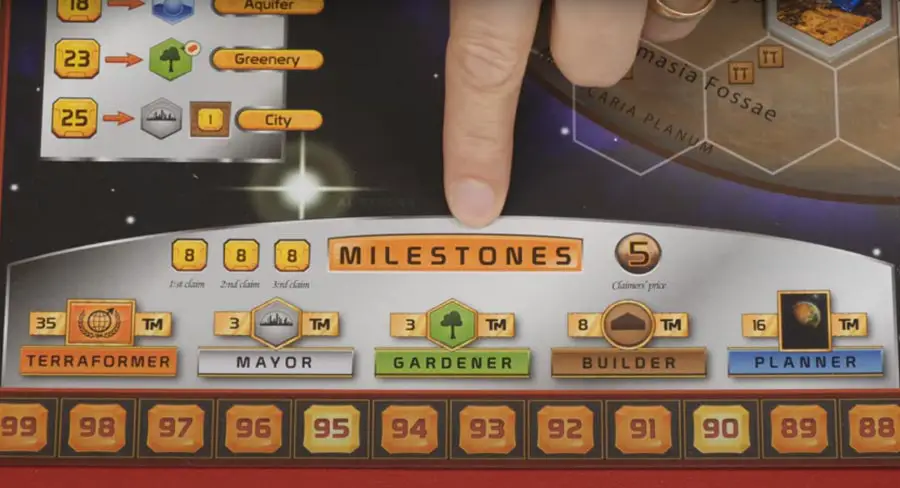
Ufunduj nagrodę
Kiedy podejmujesz akcję, aby odebrać nagrodę, płacisz odpowiedni koszt, który wzrasta po tym, jak każdy gracz wykona akcję, aby odebrać jedną nagrodę. Do zdobycia jest 5 nagród, a na koniec gry zwycięzcy otrzymują 5 punktów, a wicemistrzowie 2 punkty.
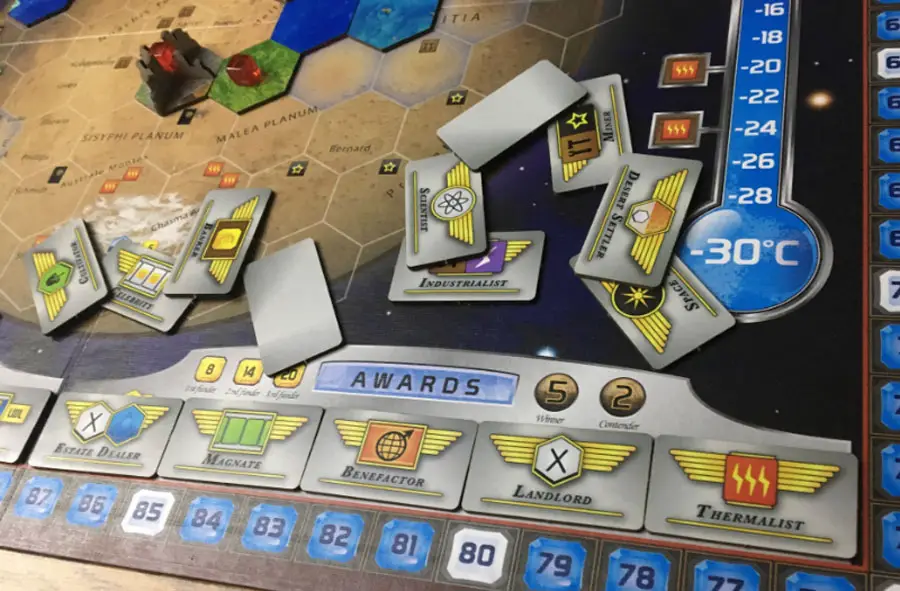
Jeśli dwóch graczy zremisuje na drugim miejscu, obaj otrzymują 2 punkty. Jeśli dwóch graczy zremisuje na pierwszym miejscu, obaj otrzymują 5 punktów, przy czym żaden inny gracz nie może zająć drugiego miejsca.
5 kategorii, w których przyznawane są Nagrody to:
- Właściciel: Większość posiadanych kafli na planszy.
- Bankier: Najwyższa wartość produkcji Megakredytów.
- Naukowiec: Większość znaczników nauki w grze, z wyłączeniem kart Wydarzeń.
- Termalista: Najwięcej kostek Heat na koniec gry.
- Górnik: Najwięcej kostek Stali i Tytanu na koniec gry.
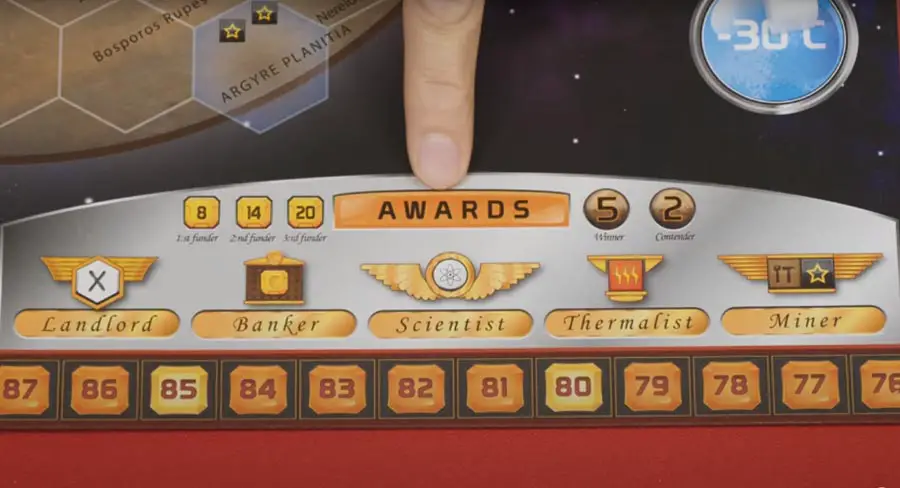
Zdolności korporacji
Now, we’ve gone through all of the actions, but it’s important to keep in mind that unique corporations may also provide you with actions and abilities that you can use in your turn. So, keep an eye out for those and use them when it’s most appropriate.
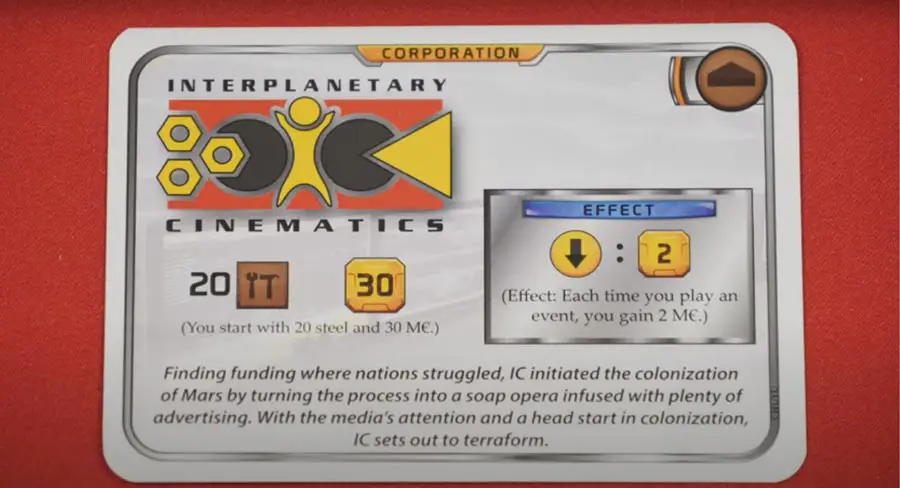
Faza produkcji
Gdy każdy wykona jakieś działanie, można przejść do fazy produkcji.
Ta faza rozpoczyna się od przeniesienia wszelkich zasobów kostki Energii, które posiadasz, bezpośrednio na pole zasobów Ciepła na swojej planszy gracza. Po tym kroku zdobywasz zasoby w oparciu o swoje aktualne poziomy produkcji.
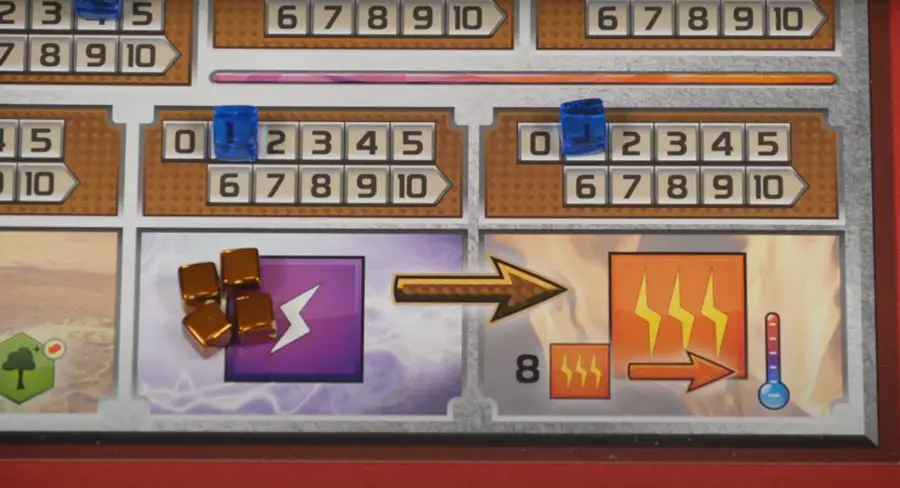
Po pierwsze, otrzymujesz zasoby Megakredytów równe twojemu TR plus wartość na twoim torze produkcji Megakredytów. Na przykład, jeśli masz TR 22 i wartość produkcji 2 na twoim torze Megakredytów, otrzymujesz w sumie 24 Megakredyty.
Reszta zasobów, które zdobywasz, opiera się na ich indywidualnej wartości produkcyjnej.
In this example, you’ll get 8 Steel, 8 Titanium, 7 Plants, 3 Energy, and 4 Heat.
Na koniec usuń wszystkie znaczniki graczy ze swoich używanych kart, aby pokazać, że można ich użyć ponownie.
Now, you’re ready to start a new generation!
Faza kolejności graczy
Unlike the first generation, the next generations will with a “Player Oder Phase” where the first-player token is passed clockwise and the generation marker is advanced one space on the board. This doesn’t necessarily affect the standard game, but it will have a significant function in the Variant and Solo versions of Terraforming Mars.
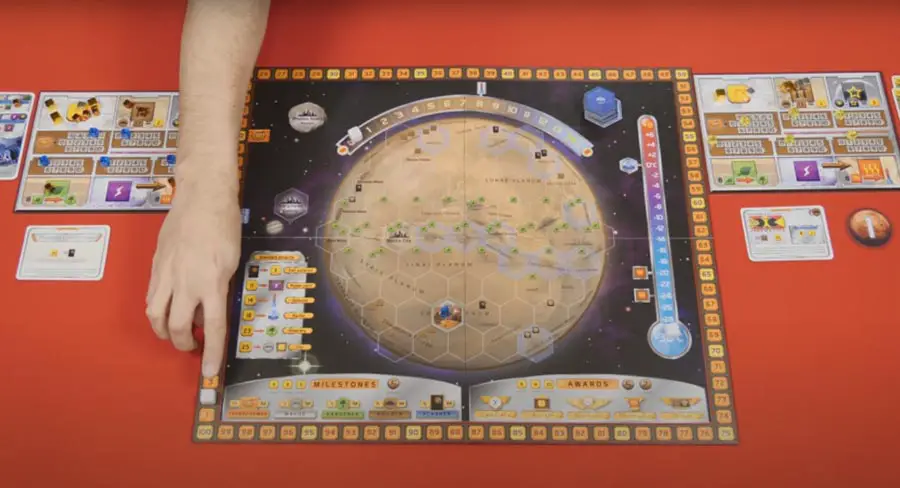
Faza badawcza
During the research phase, each player draws four cards and then chooses which to keep by paying 3 Megacredits back to the Supply. The cards you don’t choose, you place facedown on the discard pile, similar to what we did during Setup.
There’s no hand limit in the game and if you ever run out of cards from the draw pile, just reshuffle the ones from your discard pile and distribute accordingly.
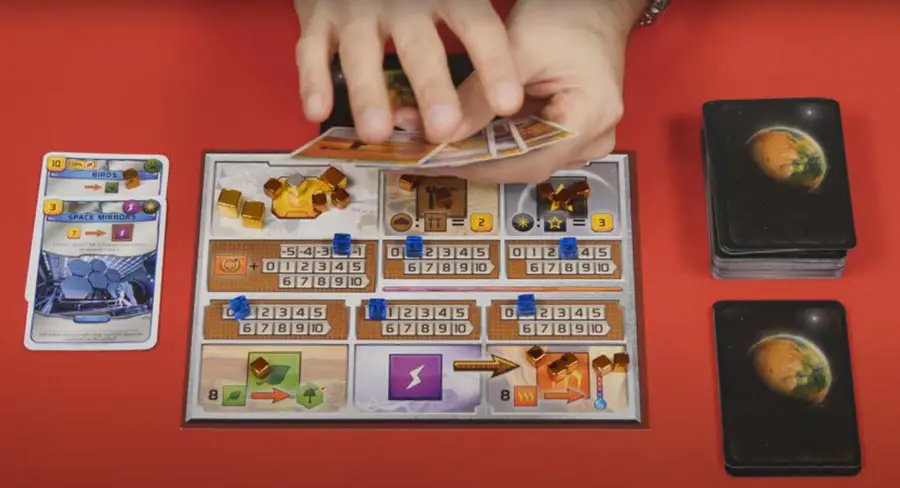
Now, it’s time again for the Action Phase, which will continue as previously explained in the first part of this guide.
The game continues until all three parameters have reached their maximum levels. After which, you’ll complete that round by finishing the Production Phase.
Wspomnieliśmy wcześniej, że gracze otrzymują ostatnią szansę na uczynienie planety nieco bardziej zieloną, więc po zakończeniu Fazy Produkcji gracze mogą zamienić dowolne 8 roślin na jeden nowy kafelek Zieleni, który można dodać do planszy.
Punktacja końcowa
Consider your Terraforming Rating (TR) as your basic score. You’ll add to this your Awards (5 points for 1st place and 2 points for 2nd place) and your Milestones (5 points for 1st place and 2 points for 2nd place).
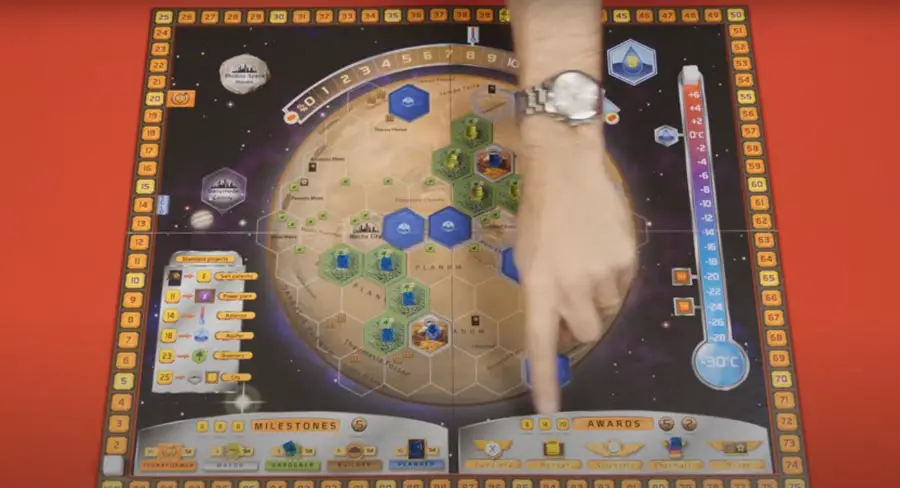
Ponownie, jeśli 2 graczy zremisuje na 2 miejscu, każdy z nich otrzymuje po 2 punkty. Ale jeśli 2 graczy zremisuje na 1 miejscu, obaj gracze otrzymują 5 punktów i żaden inny gracz nie będzie nominowany na 2 miejsce.
Otrzymujesz 1 punkt za każdy kafelek Zieleni, który masz na miejscu. Z każdego posiadanego kafelka Miasta wyznaczane są punkty za każdy kafelek Zieleni, który z nim sąsiaduje (po 1).
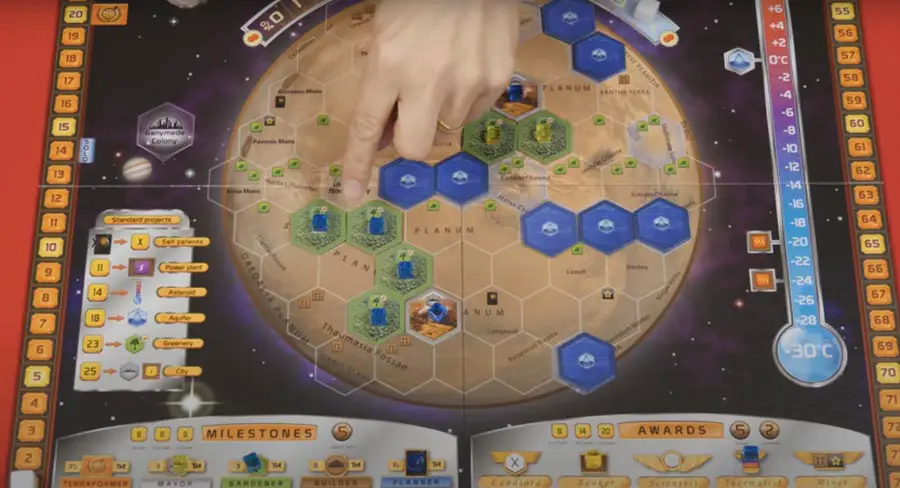
Na koniec podlicz wszystkie swoje punkty Zwycięstwa z zakrytych kart i odwróć wszystkie zakryte karty, aby zdobyć punkty również z nich.
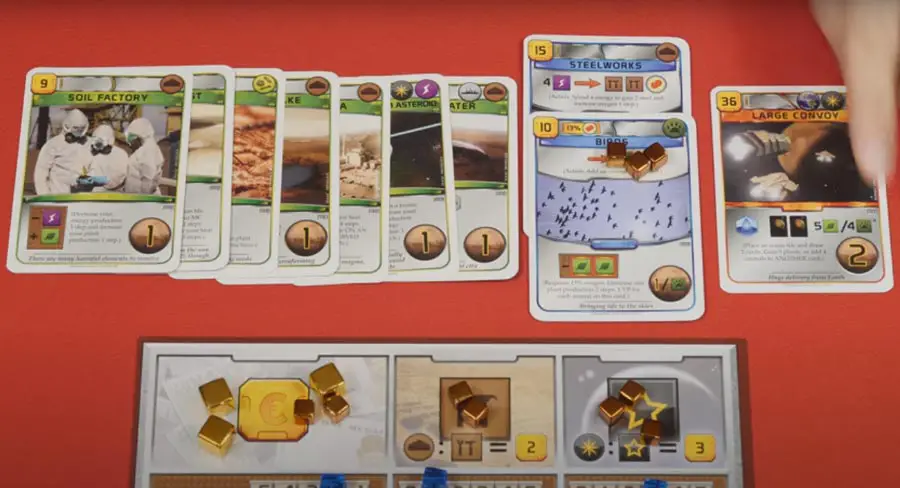
Na tym etapie zwycięzcą zostaje gracz z największą ilością punktów, ale w przypadku remisu wygrywa gracz z największą ilością Megakredytów.
Warianty terraformacji Marsa
Terraforming Mars has two variants that we’ll be briefly going over in this section. The Solo Variant and the Corporate Era.
Wariant Solo
Grając w Solo Variant w Terraformowanie Marsa, twoim celem jest terraformowanie Marsa przed upływem 14 pokoleń.
To start playing, add the Corporate Era cards to your deck. Draw 2 Corporation Cards and 10 Project Cards and keep the ones you want to play with. Just like the standard game, each project card you choose to keep in your hand will cost 3 Megacredits. Now, place one player marker on TR “14” which will be marked “Solo” on your game board. Then place one of the generation markers on TR “1.”

Next, you’ll add 2 neutral City Tiles and Greenery Tiles to your game board. To do this, draw a card from your deck and use the number on the upper left side of the card as a basis for where to place your tile. For your ease and reference, watch this video.
Kiedy wszystko jest już ustawione, możesz zacząć grać tak, jak w standardowej grze, dopóki nie osiągniesz maksimum wszystkich 3 parametrów globalnych.
Wariant z Ery Korporacyjnej
The Corporate Era Variant is an extended version of Terraforming Mars, meaning it takes longer to complete. This adds in all the corporate cards that you’d normally discard during a base game, and it also means that you start the game with ZERO production values for ALL of your resources. This is a more complicated variant of the game, which is why we don’t recommend it for beginners.
When you choose your four corporate cards, take one and pass the remaining three to the next player on your left. Keep doing this until all players have four cards in their hands and discard the ones that you don’t want to use as standard. This adds more player interaction in the game, as it can help you hinder your opponents from getting their hands on great cards. The only downside is it will slow things down a bit, too.
Wniosek
Terraforming Mars to świetna gra do grania z przyjaciółmi i rodziną. Zachęca do planowania strategicznego i stawia przed graczem wiele wyzwań, w tym budżetowanie i zarządzanie zasobami. Jest to świetna gra dla każdego miłośnika nauki, który chce zdobyć doświadczenie z pierwszej ręki w terraformowaniu planety Mars.
Mamy nadzieję, że ten przewodnik po tym jak grać w Terraforming Mars pomógł Ci zrozumieć grę trochę lepiej.
Miłego zwiedzania!